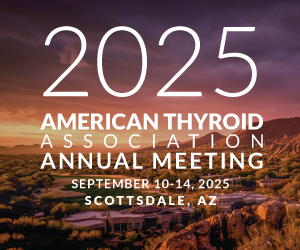
Congenital Hypothyroidism awareness: The importance of newborn screening
Liuska M. Pesce, MD
University of Iowa Stead Family Children’s Hospital
Iowa City, IA
April 16, 2021
I was reviewing the normal growth charts of a very smart 14-year-old patient with congenital hypothyroidism, whom I had followed since birth, when I heard the question:
-Doctor, what would have happened to me if I did not receive treatment?
How should I explain this to a 14- year-old? I decided to use pictures which showed severe short stature, coarse features, large tongue, coarse skin, swelling of the face and dull facies. These were historical pictures of a diagnostic term that is no longer widely used: cretinism, defined as intellectual disability and physical abnormalities caused by congenital thyroid hormone deficiency. I also reflected on how many of us have forgotten about cretinism, a frequent condition of the past, secondary to the delayed diagnosis and treatment of congenital hypothyroidism (1).
In 1950, in the book The Diagnosis and Treatment of Endocrine Disorders in Childhood and Adolescence, Dr. Lawson Wilkins wrote: “In the very young cretin, the diagnosis sometimes cannot be made with certainty because sufficient time has not elapsed for the deviation below the normal level of development to become obvious.” This meant that diagnosis and treatment was universally delayed until 2-3 months of age or longer (1,2).
Congenital hypothyroidism is defined as insufficient thyroid hormone production or action present at birth. It encompasses central or primary hypothyroidism as well as impaired thyroid hormone action. Greater understanding of congenital hypothyroidism has led to prevention, early diagnosis, timely treatment, and adequate counseling. However, we still need to optimize early diagnosis, treatment and follow up. This year, a 2020-2021 consensus guideline update was published as part of an ENDO-European Reference Network (ERN) initiative, which still emphasized the importance of newborn screening for congenital hypothyroidism for all children (3).
Newborn screening for congenital hypothyroidism (first published in 1973), obtained by heel stick, has almost eliminated the profound negative effects of thyroid hormone deficiency in growth and development (cretinism) in the countries where it is available. However, 70% of babies worldwide are born in areas without access to newborn screening. Even in the countries where newborn screening is available, it is not universally recognized that the screening methods have limitations. Some newborns may have false negative results (pre-term, low weight, and sick babies), and clinical judgement is still critical to suspect congenital hypothyroidism even if the newborn screening is normal (1,3,4,5).
Treatment should never be delayed, and close follow up by a specialist is recommended to prevent under-treatment and over-treatment, both of which have deleterious effects. Coordination between primary care providers and specialists is fundamental, and a well-planned transition to adult care is essential to prevent morbidity, poor educational and social outcomes and, in women, to improve fertility, pregnancy and newborn outcomes (3).
Most importantly, we need to continue to advocate for equity for all the children around the world, so we can completely eradicate preventable intellectual disability. Guidelines that offer best practices based on the most up-to-date scientific data can’t be followed if the necessary resources are not available.
As I end this reflection, I realize that I am lucky to search for historical pictures to explain untreated congenital hypothyroidism. However, I wonder how many children with congenital hypothyroidism around the world are asking:
– Doctor, why was I treated late?
Or … not asking any questions at all.
References:
1. Salisbury S. Cretinism: The past, present and future of diagnosis and cure. Paediatr Child Health 2003;8(2):105-6. DOI: 10.1093/pch/8.2.105.
2. Wilkins L. The diagnosis and treatment of endocrine disorders in childhood and adolescence. 1st ed. Springfield, Ill.,: Thomas, 1950.
3. van Trotsenburg P, Stoupa A, Leger J, et al. Congenital Hypothyroidism: A 2020-2021 Consensus Guidelines Update-An ENDO-European Reference Network Initiative Endorsed by the European Society for Pediatric Endocrinology and the European Society for Endocrinology. Thyroid 2021;31(3):387-419. DOI: 10.1089/thy.2020.0333.
4. American Academy of P, Rose SR, Section on E, et al. Update of newborn screening and therapy for congenital hypothyroidism. Pediatrics 2006;117(6):2290-303. DOI: 10.1542/peds.2006-0915.
5. Leger J, Olivieri A, Donaldson M, et al. European Society for Paediatric Endocrinology consensus guidelines on screening, diagnosis, and management of congenital hypothyroidism. Horm Res Paediatr 2014;81(2):80-103. DOI: 10.1159/000358198.
Disclaimer:
The ideas and opinions expressed on the ATA Blogs do not necessarily reflect those of the ATA. None of the information posted is intended as medical, legal, or business advice, or advice about reimbursement for health care services. The mention of any product, service, company, therapy or physician practice does not constitute an endorsement of any kind by ATA. ATA assumes no responsibility for any injury or damage to persons or property arising out of or related to any use of the material contained in, posted on, or linked to this site, or any errors or omissions.



